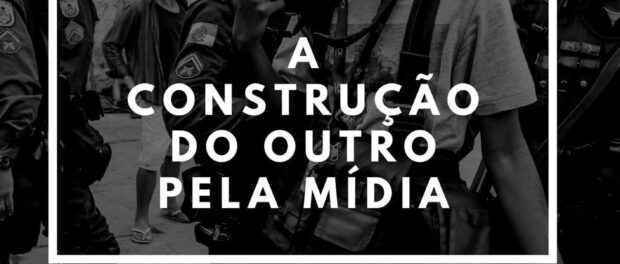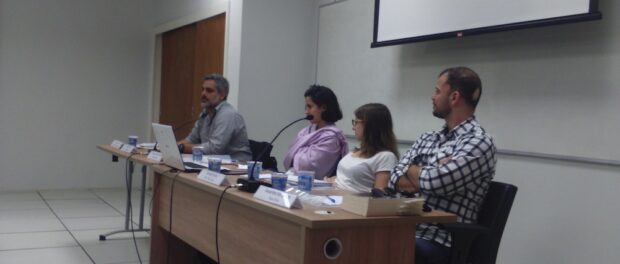
On Wednesday, September 13, the Academic Center of International Relations (Centro Acadêmico de Relações Internacionais—CARI) of the Pontifical Catholic University of Rio (PUC-Rio) hosted a debate on “The Construction of the Other by the Media,” as part of a series of events on the theme of media and international relations. The panelists were professor and Rede Globo journalist Alexandre dos Santos, Professor Renata Summa from PUC-Rio’s International Relations Institute, Globo News journalist André Fran, and Thaís Cavalcante, a journalist from Complexo da Maré and correspondent for The Guardian and RioOnWatch. The debate was mediated by CARI’s Carolina Soares, who emphasized that the construction of ‘the other’ comes about in opposition to a construction of an ‘us’ identity.
Renata Summa opened the conversation by broadly defining the idea of ‘the other’ as a person or group that does not fit the dominant group’s identity characteristics. The media play a crucial role in establishing and spreading a society’s definition of the dominant identity, Summa explained. She stressed that the media is a powerful tool for a dominant group (whether a political party, race or social class) to influence people’s opinions and gain control over, and legitimacy in, the eyes of the population.
Building on the discussion of media’s power in constructing the image of ‘the other,’ Alexandre dos Santos underscored the power and responsibility of the audience–as consumers in the media industry–in the building of ‘the other.’ The professor explained that all narration and representation is produced through someone’s filter—all articles are written through the filter of the journalist. But additionally, he added, representations are filtered again by the reader, who consciously or subconsciously may choose to read only what confirms his or her opinion. The influence of the point of view of the writer or of the reader always plays a role in the construction of ‘the other,’ and Santos believes it is a duty of the media consumer to be aware of it and look for a different point a view. “Part of the construction of the other through the media is about what people let the media build,” he argued.
André Fran stated that it is important for journalists to try to break the cycle of negative and incomplete representations of ‘the other’ by going to meet ‘the other’ without the barriers that usually exist between reporters and the interviewed. He explained that it is only by truly telling the story of people as they narrate it, reflecting their everyday conditions of existence, that it is possible to break the prejudices held by the audiences far-removed from their realities.
Participating via Skype, Thaís Cavalcante narrated her own story as a favela resident, as favelas have been historically stigmatized by the mainstream media while their residents are constructed as ‘the other.’ Born in Maré, Cavalcante recounted that she didn’t grow up seeing or hearing how the mass media spoke about her home on the TV or radio; instead, it was later on in her life that she became conscious of the discourse around and representation of favelas and the people inhabiting them. Speaking about this discourse, she said: “I didn’t feel it represented me because it was always and only about violence. It spoke about the favela as a place that is poor in culture, poor in education, a place not to visit.” She gave first-hand evidence of the impact such external images can have on one’s own internalized understanding of the world: “I didn’t like living there because I felt criminalized and marginalized as a favela resident.” Cavalcante explained it was this experience that pushed her to get involved in community media to try to show a different and more positive side of favelas. Understanding the power of media in influencing people’s opinions, she decided to use that same power to counter the criminalization and marginalization of her type of neighborhood.
She pointed to another devastating impact of negative stereotypes, arguing that when favelas are only represented as violent in the mainstream media, this image of the favela legitimizes the further application of violence. As a result, it is essential to also talk about the commerce, music, and culture occurring in, and often deriving from, these places. Therefore, she believes community media are a vital part of the resistance to the construction of the criminal image of favela residents and their being seen as ‘the other’ by the dominant media.
All speakers agreed on the responsibility of mainstream media in the construction of the dichotomy of ‘us’ and ‘them,’ and the need for a closer, more loyal narration of people and communities’ stories in order to break it.

